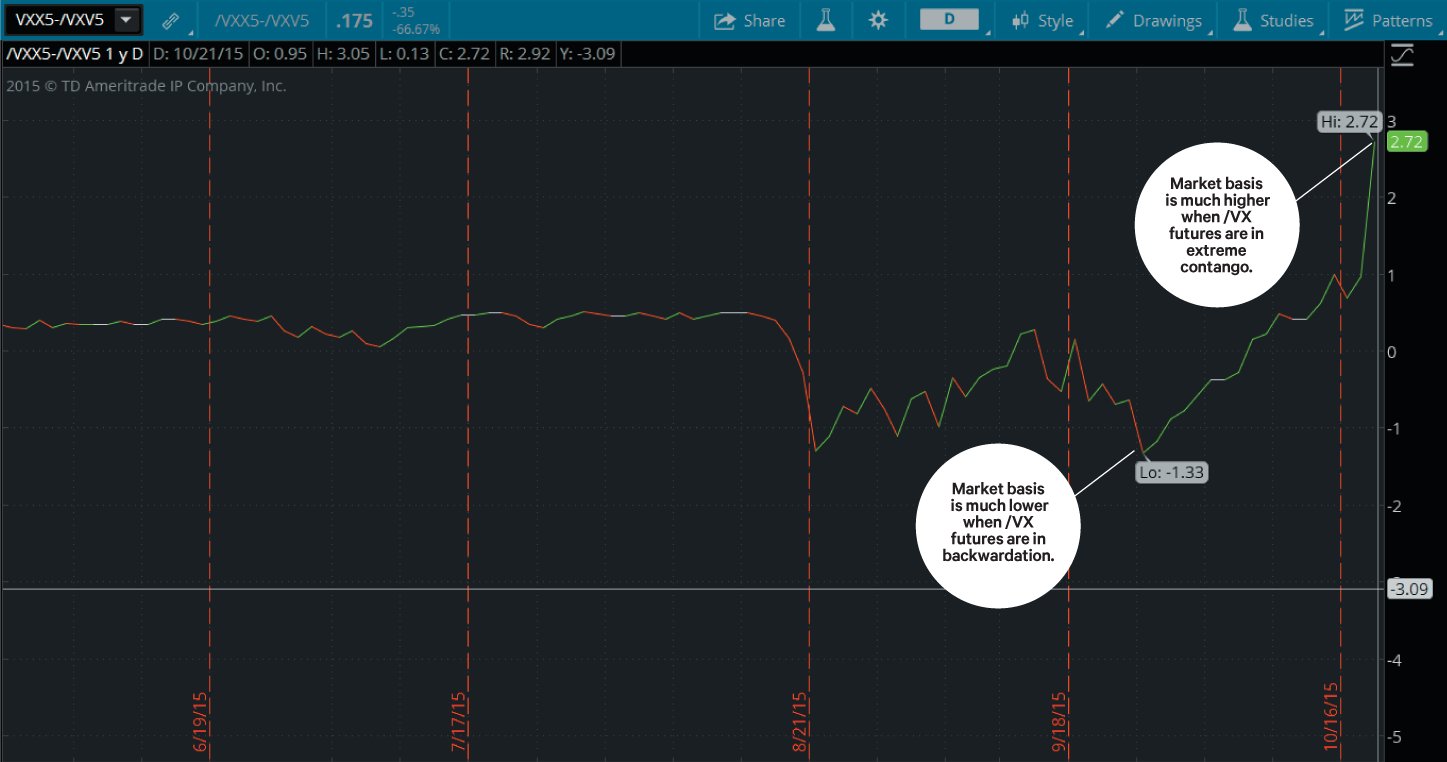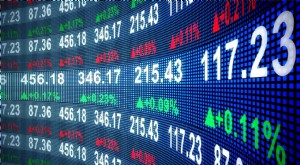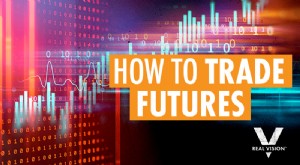So handeln Sie Futures in 3D:Basis-Trading
Futures können eine einfache und kapitaleffiziente Möglichkeit sein, entweder zu spekulieren oder abzusichern. Sie denken, der Maispreis wird steigen? Der Kauf eines /ZC-Mais-Futures-Kontrakts ist eine einfachere Möglichkeit, eine Wette zu platzieren, als eine Maisfarm zu kaufen und Ihre eigene anzubauen. Wie wäre es mit einer kurzfristigen Absicherung eines großen S&P 500-Aktienportfolios, kurz vor einer Fed-Ankündigung? /ES S&P 500-Futures passen in diese Rechnung. Genau wie Aktien, Futures können langfristige Trades oder schnelle Skalps sein. Aber im Gegensatz zu Aktien Futures können aufgrund ihrer Basis auch unterschiedliche Handelsmöglichkeiten bieten, die nur wenige unerfahrene Einzelhändler kennen.
Basis 101
„Basis“ ist die Bezeichnung für die Differenz der Futures-Preise in verschiedenen Fälligkeiten, oder der Kassapreis („Spot“) des zugrunde liegenden Produkts und der Futures-Preis. Futures-Preise in den verschiedenen Fälligkeiten unterscheiden sich aufgrund der Carry-Kosten voneinander und vom Spot-Preis. und die Auswirkungen von Angebot und Nachfrage. Dieser Unterschied bildet die Grundlage. /ES-Futures, zum Beispiel, haben Verträge, die im März auslaufen, Juni, September, und Dezember. /ZC-Mais-Futures haben Kontrakte, die im März auslaufen, Kann, Juli, September, und Dezember. /ZB-Anleihen, /GC-Gold und, /CL-Rohöl-Futures haben ihre eigenen Verfallszeiten.
Handelsbasis
In einem Wort, Basis-Trading ist der Kauf eines Futures in einem Ablaufmonat, und in einem anderen Verfallmonat zu verkaufen – wie zum Beispiel den März /ES zu verkaufen und den Juni /ES zu kaufen. Es ist eine Art Intermarket-Paar-Trading, aber mit fast 100 % Korrelation. Sie spekulieren auf die zunehmende und breitere Basis, oder abnehmen und verengen. Da die beiden Futures auf demselben Basiswert basieren (z.B. S&P 500, Staatsanleihen, Rohöl, etc.), sie sind stark korreliert. Sie neigen dazu, sich gleichzeitig auf und ab zu bewegen. Aber wenn sie sich nicht gleichzeitig bewegen, oder um den gleichen Betrag, die Basis ändert sich.
Da die Basis negativ sein kann, wenn der Preis des Futures mit weiterem Verfall niedriger ist als der Preis des Futures mit näherem Verfall (auch bekannt als „Backwardation“), Es ist wichtig zu wissen, in welche Richtung sich Ihrer Meinung nach die nahe Zukunft entwickeln wird, relativ zum Back-Monat-Future. Einige Futures wie /ES befinden sich regelmäßig in Backwardation, die Basisverbreiterung bedeutet also, dass es negativer wird. Wenn Sie dachten, es würde sich ausweiten, Sie könnten erwägen, den kurzfristigen Future zu kaufen und den Back-Month-Future (z. B. Sie würden März /ES kaufen und Juni /ES shorten).
Wenn der Preis von Futures mit weiterem Verfall höher ist als Futures mit näherem Verfall, das nennt man „contango“. Im Contango, die basis ist positiv. Wenn /CL-Futures im Contango sind, und du dachtest, die Basis würde sich erweitern, Sie könnten erwägen, den nahen Monat /CL-Future zu verkaufen, und den Kauf des Back-Month- /CL-Futures.
4 Schritte zur Basis
Auf Handelsbasis, du musst die basis sehen. Damit, Denkerschwimmen ® hat Sie abgedeckt.
1. Auf der Registerkarte Handel von thinkorswim ® , Sie können die verfügbaren Futures-Abläufe sehen, indem Sie das Wurzelsymbol (z. B. /ES) eingeben und "Alle" aus dem Dropdown-Menü auswählen.
2. Um den Basispreis zwischen aufeinanderfolgenden Fälligkeiten von Futures anzuzeigen, Klicken Sie auf das Dropdown-Menü "Verteilen" und wählen Sie "Kalender".
3. Klicken Sie auf den Pfeil neben einem der Futures, um den Basispreis zu erweitern. das ist der weitere (oder rückwärtige) Ablauf, minus dem näheren Ablauf.
4. Von dem soeben eröffneten Basispreis, Sie können Chart-Basis erstellen, indem Sie mit der rechten Maustaste auf das „=“ vor dem Futures-Symbol klicken. und folgen Sie dem Klickpfad „Weitere Infos…“>TOS Charts>oberes linkes Quadrat im Diagrammrastermenü.
ABBILDUNG 1: Source:thinkorswim by TD Ameritrade. Nur zu illustrativen Zwecken.
Basis Trading In the Real World
You may consider the futures basis because they can be traded by themselves, kind of like stocks pairs trades. Zum Beispiel, maybe you don’t have a bullish or bearish bias on the futures’ underlying product itself. But considering the futures basis, you think it might move higher or lower.
Trading the futures basis also has potential advantages over stock pairs trading. Zuerst, the contract and tick size are the same for a given future. You don't need to adjust the quantities of the trade to account for different contract specification. Second, the margin requirement for the basis trades can be lower than for a single long or short future because the basis trade is simultaneously long and short futures. The basis tends to have smaller price changes than the individual future would. So the margin requirement is also smaller.
Let’s look at three futures basis trading scenarios.
Crude Oil (/CL)
Crude oil futures contracts typically go out a couple of years. They’re one of the most liquid, actively traded futures contracts, and the basis can move around a lot. To understand why, think about how crude oil gets turned into gasoline and other “stuff.” It gets pumped out of the ground and transported to a refinery, and that costs money. If the oil is stored, there are insurance and storage fees, as well as interest charges if you’re borrowing money to buy it.
All those things go into the basis of /CL futures, and would make the further-term futures more expensive than near-term futures because those costs are built into the futures’ prices. But with the futures basis, there’s also the expectation of over- or under-supply in the coming months and years. You can see that when you look at /CL futures prices. Backwardation in /CL can happen when the market sees a shortage in crude oil, and where near-term demand outstrips immediate supply. The price of the near expiration /CL future is pushed higher than the back month. But /CL is more often in “contango, ” where the carry costs make the back months slightly higher than the near months, and there is Backwardation in /CL can happen when the market sees a shortage in crude oil, and where near-term demand outstrips immediate supply. The price of the near expiration /CL future is pushed higher than the back month. But /CL is more often in “contango, ” where the carry costs make the back months slightly higher than the near months, and there is equilibrium between supply and demand. If you see /CL in backwardation and you think the causes are temporary, and that /CL will move back to contango, you could consider shorting the near-expiration /CL and buy the further-expiration /CL. The risk, selbstverständlich, is that /CL could move further in backwardation, resulting in a loss on the trade. And there’s never a guarantee that contango has to happen in the future. But the trade could be profitable if the futures move back to contango before the expiration of the near-term future.
S&P 500 Index (/ES)
One of the most widely watched and actively traded futures is the /ES contract based on the S&P 500 stock index. /ES trades until 3:15 p.m. CT during “regular” market hours. The price of /ES is based on the value of the stocks in the S&P 500 (which is the SPX index), and the cost to carry the portfolio of those stocks. There is an interest charge to borrow money to buy shares. The interest is offset by dividends that are paid by the S&P 500 stocks.
The net impact of interest and dividends determines the basis between the / ES and the SPX. Nowadays with interest rates low relative to dividends, /ES futures are usually in backwardation, and the basis doesn’t fluctuate much. But because S&P 500 stocks stop trading at 3:00 p.m. CT, so, auch, does the price of the SPX stop updating. And in the 15 minutes between 3:00 p.m. and 3:15 p.m., when the /ES continues to trade, it can move higher or lower than what the basis calculation would suggest based on news that arrives after 3:00 p.m., or on the opening of large positions in /ES in the last 15 minutes of trading that anticipate the next day’s price movement.
If the /ES to SPX basis is $-10, when the /ES moves up relative to where SPX closed and makes the basis $-8, zum Beispiel, that can signal a stronger open the next day. If / ES moves down relative to the SPX closing price to make the basis $-12, that can signal a weaker open the next day. Looking at the /ES to SPX basis before and after 3:00 pm can give you a clue as to the next day’s opening price action. This may impact stop orders, and even technical indicators you might be tracking.
CBOE Volatility Index (/VX)
Volatility futures might be the trickiest to understand. But they might offer the most interesting opportunities. The CBOE Volatility Index (VIX) is derived from the out-of-the-money SPX option prices. When traders anticipate larger price changes in the SPX (i.e. more volatility), the out-of-the-money SPX option prices can increase in price. That, in turn, pushes up the VIX. When traders anticipate smaller price changes in the SPX (i.e., lower volatility), the out-of-the-money SPX prices can drop, which in turn drives the VIX lower.
You can’t trade the VIX directly, and /VX futures are a way to speculate on the direction of volatility. But /VX futures are only modestly tied to the VIX. “Modestly” because /VX settles to the VIX settlement value at their expiration. But there isn’t any cost of carry between the VIX and /VX futures be- cause you can’t buy the VIX like you can buy crude oil or a stock portfolio. That makes /VX futures pure indications of how much future volatility the market anticipates. The basis you see between the near and further month in /VX futures reflects whether the market sees more volatility near term or longer term.
Most of the time /VX futures are in contango—where the market expects more volatility the further into the future you look. But when the market panics and drops, generally the VIX rallies the most, the closest expiration /VX future rallies a bit less, and further expiration /VX futures rally a little less than those. That can push /VX futures into backwardation, and make the basis negative.
Figure 2 charts just this scenario, when a market dropped and pushed volatility higher, and the /VX basis became negative.

FIGURE 2:NEGATIVE BASIS
To view basis on /VX, you have to enter it manually as a pair (i.e., longer-term future minus shorter-term future, or /VXX5-/VXV5 as shown above). Most of the time, /VX futures are in contango, as was the case prior to August in the chart. Source:thinkorswim by TD Ameritrade. Nur zu illustrativen Zwecken.
Most of the time, the price of the back-month /VX future is higher than the price of the near-month /VX future, and the basis is positive. When the market became more volatile, the basis became negative. If you believe the market will calm down, and the front-month /VX will drop relative to the back month, and the basis will go from negative to positive, you could consider shorting the front-month /VX future and buy the backmonth /VX future. That trade could be profitable if the basis goes from negative to positive. But the trade would lose money if the basis became more negative—which is something that happened in the 2008 market crisis.
At the closing bell, /VX basis trading isn’t for the faint of heart. If you’re already a proficient futures trader, consider this another tool in the strategy toolbox. But even if you’re not ready to trade it, /VX basis can certainly offer you clues as to how the market is forecasting volatility.
Open a Futures Account
For qualified accounts, you’ll need Level 3 options approval to trade futures. Log in to your account at tdameritrade.com. Under the Trade tab, go to Futures &Forex for more information.
Futures-Handel
- Schmale Basis
- Sind Sie bereit, Futures zu handeln?
- Wie funktionieren S&P-500-Futures?
- Eine Einführung in den Handel mit Silber-Futures
- So handeln Sie Dow-Jones-Index-Futures
- Papierhandel
- Wie man Rohöl handelt
- So starten Sie den Handel auf den Märkten für Agrarrohstoffe
- Wie man Rohstoff-Futures mit Software handelt
-
 Wie man Aktien handelt
Wie man Aktien handelt Der Handel mit Aktien mag glamourös klingen, Aber hinter den Kulissen ist es tatsächlich viel harte Arbeit und kann umfangreiche Recherchen erfordern. Auch wenn es nicht immer einfach ist, neue Anlege...
-
 So beginnen Sie mit dem Handel mit Futures
So beginnen Sie mit dem Handel mit Futures Von:Wayne Duggan Für neuere Händler, Futures-Kontrakte mögen wie ein komplizierter Markt erscheinen, der nur erfahrenen Händlern vorbehalten ist. Aber Futures sind wie jedes Handelsinstrument. We...


